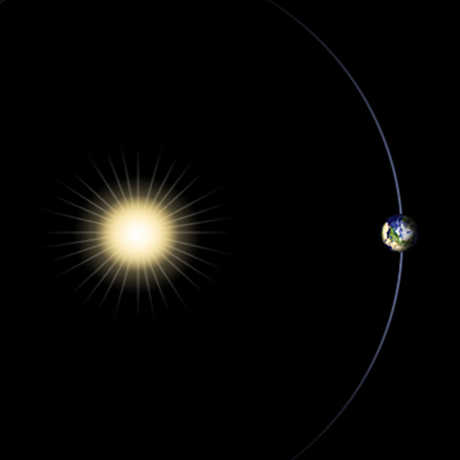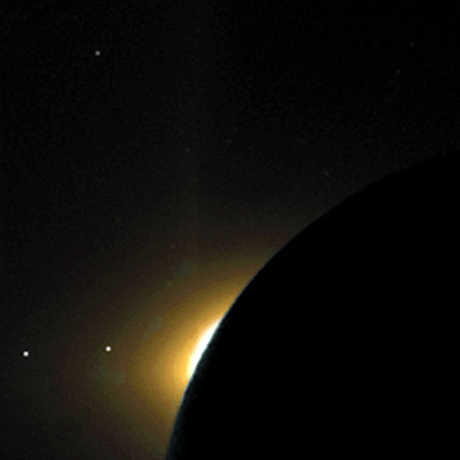
"Star" © 2014 Tom Hall
Constellations have been used for centuries for navigation and time keeping. In this interactive lesson, students will learn the difference between their sun sign and their birthday stars.
In this activity students will:
- observe how different stars are visible at different times of the year.
- learn what stars are visible at the time of their birthday.
- discover the difference between their astrological “sign” and their birthday stars.
- A lamp to represent the Sun at the center of the circle
- Twelve Zodiac Signs and Four Seasons Signs from Kinesthetic Astronomy: Set Up
- Painter’s tape (if you are taping these signs to chairs or walls)
- zodiac: a belt-shaped region in the heavens on either side to the ecliptic; divided into 12 constellations
- ecliptic: the plane defined by a planet’s orbit; an imaginary line in the sky traced by the Sun, moon and stars as it moves in its yearly path through the sky.
- orbital plane: The plane, passing through a planet's center of gravity, in which a satellite orbits
- Have all students line up on the kinesthetic circle and ask them to turn to midnight.
- Have them note the names of two constellations they can see.
- Now have them move ¼ of an orbit (3 months – the Equinox and Solstice students can be the guides for this amount of orbit). Have students again note the names of two constellations they can see. Ask questions such as:
- Are you seeing different stars at this new time of year? (Yes) Shift again, if needed to make the point.
- Are the constellations in different places in the sky? (Yes)
- Why do you see different stars at different times of the year? [Because at different times of year, the night side of Earth faces out in different directions in space and so we see different stars.]
- At this point students should understand the seasons and that different stars appear at different times of the year. Tell all students: “Go to your birthday.”
- This helps confirm that students are making the connection between a date and the position of Earth in its orbit around the Sun.
- Check results by asking each student to report out the date of their birthday. Make any needed adjustments by drawing attention to the dates of the solstices and equinoxes and the direction of Earth’s orbit around the Sun.
- Have students start with the proper tilt toward Polaris. Invite them to “have their kinesthetic birthday”.
- Students complete one rotation while keeping their axis tilted towards Polaris.
- Assist students who do not rotate toward the east and/or who do not maintain the orientation of their “North Poles” toward Polaris.
- For good humor, sing “Happy Birthday” as students perform their tilted rotations.
- Have the students draw a picture or write about what they will see in the sky every year on their birthday.
Have students write a story about the different constellations or study other people’s stories about the stars in the sky. You may also have students study star charts and make up their own constellations.
The word “zodiac” comes from zoo and literally means the “zoo in the sky” referring to the animals that make up the constellations. These specific constellations are in the area of the sky in which the sun, moon and planets appear to move. This area is called the “ecliptic” and is the projection of earth’s orbital plane into outer space. The band of the zodiac constellations are between eight degrees north and south of the orbital plane.
These constellations can be seen every year at the same time and were used by sailors for navigation and ancient peoples to track the passing of time. In this activity students will learn what their birthday stars are, which means that they will discover what stars are always present on their birthday.
Students who know their astrological signs may be confused as to why they don’t see that constellation in the sky on their birthday. So, is the zodiac set up backwards? No, your sign of the Zodiac is your “Sun sign”, meaning that your constellation is in the background when you look in the direction of the Sun on your birthday. If the Sun’s light were blocked you would be able to see it. If you are a Leo, we say, “the Sun is in Leo.”
When astrological signs were first defined, the Sun was “in” Aries at the Spring Equinox. Note from the diagram that the Sun is now between Pisces and Aquarius. This is due to the “wobble” of Earth’s rotation axis over thousands of years (precession). It means that the zodiac sign on your birthday no longer matches up with your sign as originally defined.
This lesson is adapted from the Kinesthetic Astronomy program developed by the Space Science Institute, 2004.
Image: "Star" by Tom Hall, licensed and modified under CC BY 2.0; originally sourced from https://www.flickr.com/photos/127665714@N08/15188916669
Fifth Grade
5-ESS1-2. Represent data in graphical displays to reveal patterns of daily changes in length and direction of shadows, day and night, and the seasonal appearance of some stars in the sky.


